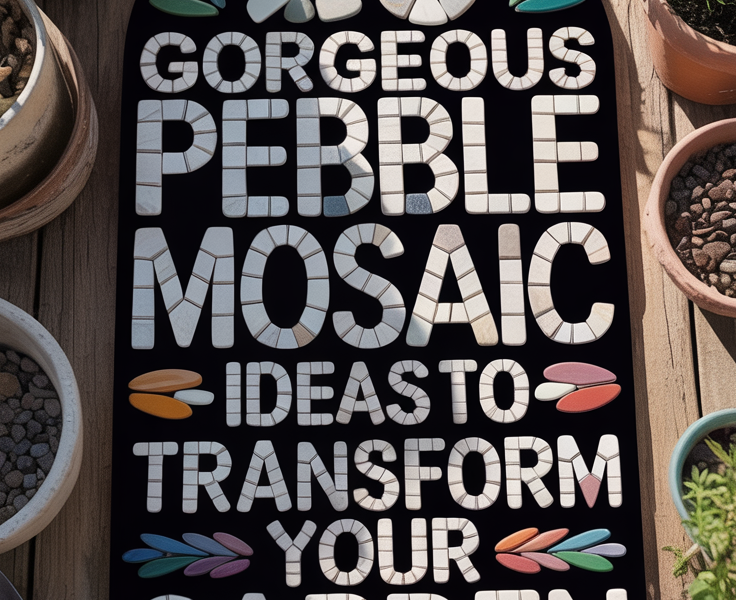Did you know that adding just five flowering plants to a tiny outdoor space can boost its visual appeal by 70%? That’s the magic of cottage-style design—it turns cramped corners into dreamy retreats. Whether you have a postage-stamp patio or a narrow balcony, this aesthetic blends romance with practicality.
Vertical growth and layered textures are your best friends here. Think climbing roses, trailing ivy, and stacked herb pots. Vintage charm comes from upcycled finds—like wigne crate beds or repurposed gutter planters. Best part? You don’t need a green thumb to pull it off.
Key Takeaways
- Cottage gardens work in tight spaces, including urban balconies.
- Vertical planting maximizes limited square footage.
- Mix textures with flowers, herbs, and trailing vines.
- Upcycled containers add vintage character.
- Low-maintenance picks keep upkeep simple.
1. Ideas for Small English Cottage Gardens (Even Balconies!) to Inspire You
Iron arches dripping with roses prove that cottage style isn’t confined to sprawling landscapes. Even a tiny balcony can channel that whimsical vibe—start with potted trees like dwarf hydrangeas and let ivy cascade from railings. Instant charm, zero yard required.
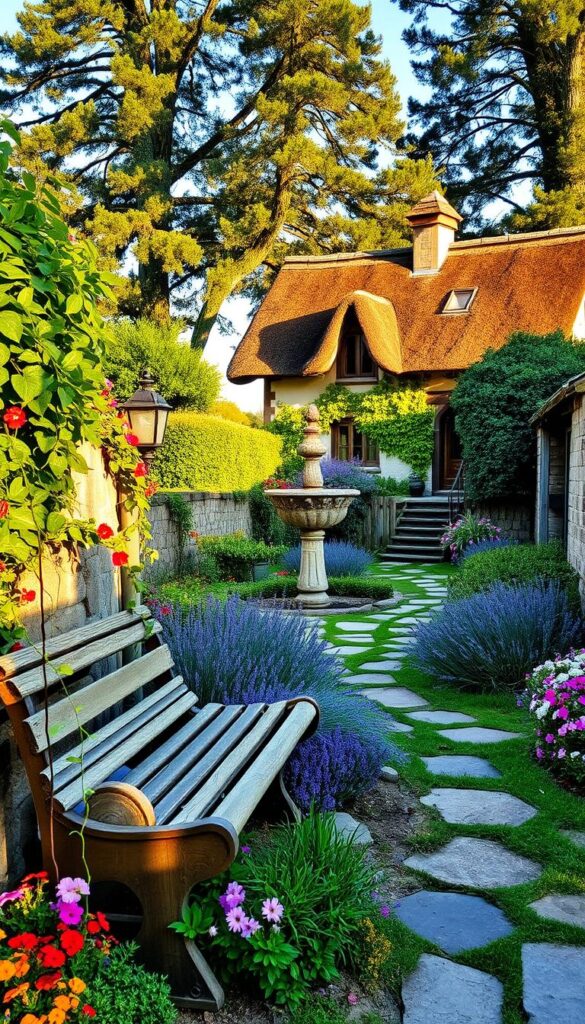
Handmade Farmhouse’s arched trellis tutorial is a game-changer for vertical impact. Pair it with sweet peas or clematis for a fairytale effect. Jane Merritt’s rainbow-tiered terra-cotta pots (featured in The House That Lars Built) add pops of color without cluttering floorspace.
No lawn? No problem. Sugar & Cloth’s faux grass stepping stones create pathways that fool the eye. For a layered look, Tilly Design mixes raised beds with ground plots—herbs up top, sprawling blooms below. It’s all about working smarter, not harder.
Vintage wheelbarrows repurposed as planters bring rustic flair. Pair them with lavender borders for a scent-sational twist. Whether your canvas is a fire escape or a postage-stamp patio, these tricks make every inch bloom.
2. Vertical Gardening: Maximize Your Space
Vertical gardening solves the biggest challenge of tiny plots—how to grow more without expanding your footprint. By training plants to climb rather than spread, you’ll create living walls that add depth and drama. This approach works equally well on brick walls, balcony railings, or freestanding structures.
Build an Arched Trellis for Climbing Vines
Handmade Farmhouse’s tutorial shows how bent metal rods become instant vertical real estate for plants. Russian ivy and sweet peas thrive here, covering the structure in weeks. The arch creates a gateway effect—perfect for defining entryways or hiding utility areas.

Repurpose a Ladder as a Vertical Planter
Stainless steel cable ties transform old ladders into DIY plant towers. Secure wooden planks across the rungs to hold terra-cotta pots. Try mixing herbs like thyme and oregano with trailing nasturtiums—edible and eye-catching.
Grow a Lattice Green Wall
Attach lattice panels to fences or exterior walls for instant garden potential. Pretty in the Pines recommends pairing them with evergreen shrubs for year-round texture. Add flowering clematis in spring for pops of color against the green backdrop.
3. Raised Beds and Compact Planters
Raised beds solve two problems at once—poor soil and tight spaces—while adding instant structure to your layout. Whether you’re working with a balcony or a backyard nook, these solutions keep your plants thriving and your design intentional.
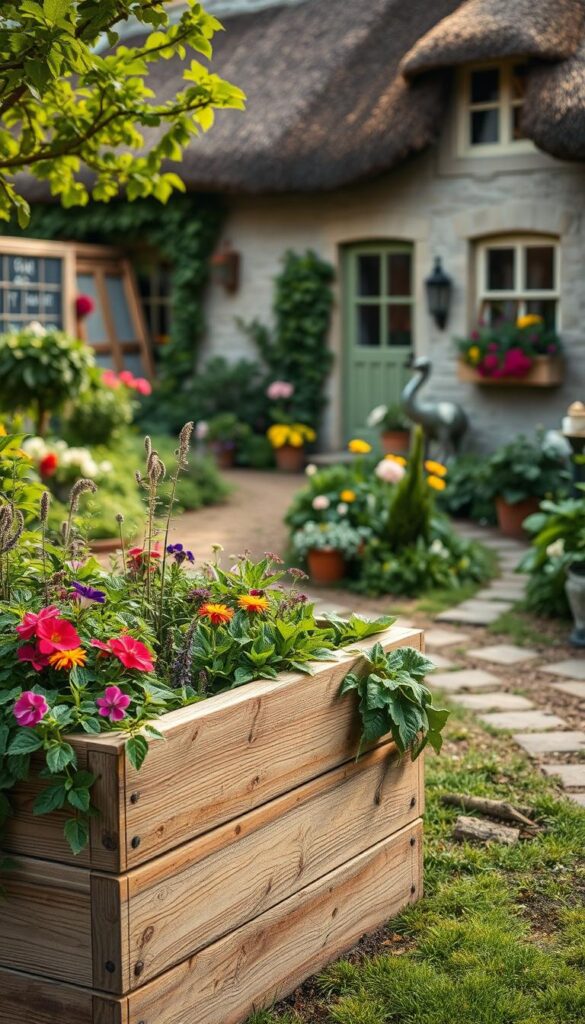
DIY Raised Garden Beds for Better Drainage
Cedar beds resist rot naturally, but composite materials offer longevity with zero maintenance. Designer Trapped’s tutorial shows how to build one in an afternoon—just layer gravel at the base for drainage. Elevate the bed 12 inches to protect roots from soggy soil.
Tiered Terra-Cotta Pots for Rainbow Blooms
Jane Merritt stacks pots by size, planting each tier with a single color for bold impact. Try pairing purple petunias with yellow marigolds. Bonus: The porous clay regulates moisture, reducing overwatering risks.
Transform Wine Crates into Mini Garden Beds
Line crates with pond liner to prevent wood rot—Tilly Design recommends placing them where they’ll get 6+ hours of sun. Plant herbs like basil alongside trailing nasturtiums for a edible-and-pretty combo.
4. Creative Container Gardening
Who says your planters need to stay grounded? Elevate your greenery with these space-smart container hacks. They turn tight corners into lush displays—no yard required.

Hanging Gutter Planters for Porches
Pretty in the Pines’ nylon rope rigging turns rain gutters into floating herb gardens. Use stainless steel hooks to suspend them from eaves or railings. Drought-tolerant sedums thrive in these shallow trays—their roots stay cozy while leaves spill over edges.
Wheelbarrow Gardens: Whimsical and Mobile
Drill DIY drainage holes in vintage wheelbarrows for movable flower beds. Pair trailing thyme with strawberry plants—the combo saves space and delivers edible rewards. Bonus: Roll your garden to chase sunlight across compact areas.
Turn a Serving Tray into a Succulent Display
Buff Strickland’s tutorial shows how to transform trays into desert landscapes. Line them with pebbles for drainage, then arrange hens-and-chicks in geometric patterns. These low-maintenance displays add texture to your home’s exterior walls or balcony tables.
- Gutter systems support 15 lbs when secured with marine-grade rope
- Sedums need only 3″ of soil depth—ideal for shallow containers
- Wheelbarrows should tilt slightly forward to prevent water pooling
5. Small-Scale Water Features
Water transforms any outdoor space into a soothing retreat—even in tight corners. A tiny pond or birdbath adds movement, sound, and wildlife appeal without hogging precious square footage. These features work on patios, balconies, or tucked between flower beds.

Add a Mini Pond with Natural Stones
Dolah’s guide proves you can create a water garden in any container—even a whiskey barrel. Start with a pond liner and add a small pump for gentle circulation. Dwarf water lilies thrive here, their pads floating like green coins.
Key elements for success:
- Use gravel slopes for critter access
- Position in part sun to prevent algae overgrowth
- Include oxygenating plants like hornwort
For inspiration, check out these space-saving pond designs that fit anywhere.
Birdbaths for Wildlife and Charm
Place a shallow bath near bee-friendly flowers like lavender. Kate Anne’s wind chime design doubles as a perch—its gentle sounds attract feathered visitors. Keep water fresh to prevent mosquitoes.
Pro tips:
- Choose textured basins for grip
- Elevate on pedestals to deter predators
- Add a solar fountain for moving water
These water features prove big impact comes in small packages. They’re the secret sauce for gardens that engage all senses.
6. Balcony-Specific Cottage Garden Ideas
Balconies can burst with cottage charm—no sprawling estate needed. You’ll love how potted trees and cascading vines transform railings into living art. Even the tiniest ledge becomes a floral stage with these space-smart strategies.
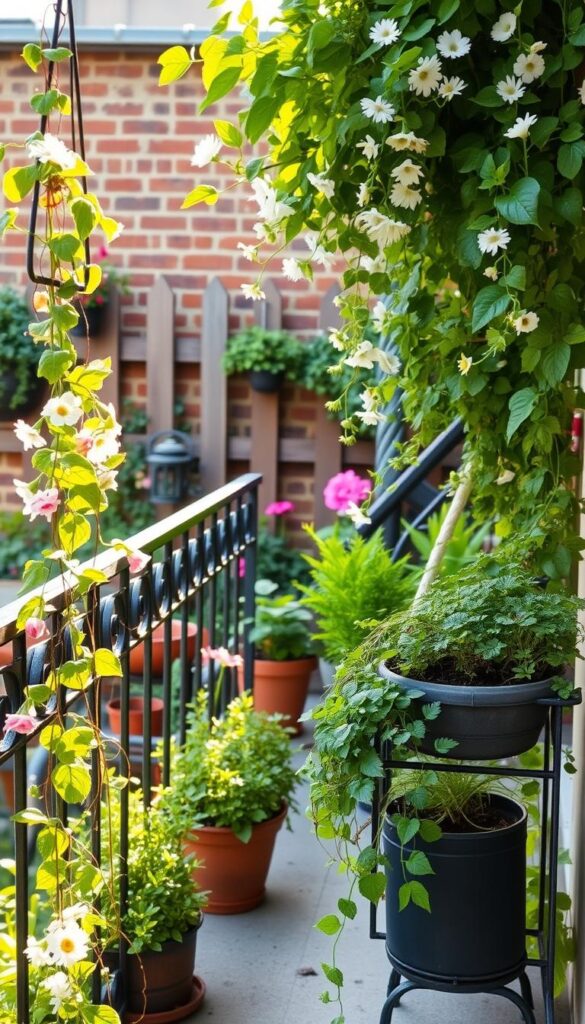
Potted Trees and Shrubs for Privacy
Dwarf citrus trees in self-watering pots deliver foliage and fruit without crowding. Iuliia Bondar’s compact layout proves a Meyer lemon tree thrives in 18-inch containers. For evergreen coverage, try arborvitae ‘Mr. Bowling Ball’—its spherical shape fits tight corners.
Trellis panels double as privacy screens when planted with climbing hydrangea. Anchor them with galvanized brackets for wind resistance. Pro tip: Angle panels slightly outward to maximize light exposure.
Trailing Vines for Railing Displays
Stainless steel planter brackets turn railings into vertical real estate. Petunias spill over edges like confetti, while evergreen clematis ‘Armandii’ provides year-round greenery. For edible options, strawberries cascade beautifully from hanging pockets.
Mix textures by pairing thyme’s fine foliage with heart-shaped ivy leaves. The combo creates depth without clutter. Remember: Group plants with similar water needs to simplify care.
- Self-watering pots reduce maintenance by 40%
- Clematis needs at least 6 hours of sunlight
- Use marine-grade rope for hanging planters
7. Cottage Garden Flowers for Small Spaces
Color-blocked flower beds turn cramped corners into vibrant showstoppers without demanding extra room. The trick? Pairing the right plants with your space’s scale. These picks deliver maximum impact—whether you’re working with a balcony railing or a postage-stamp plot.
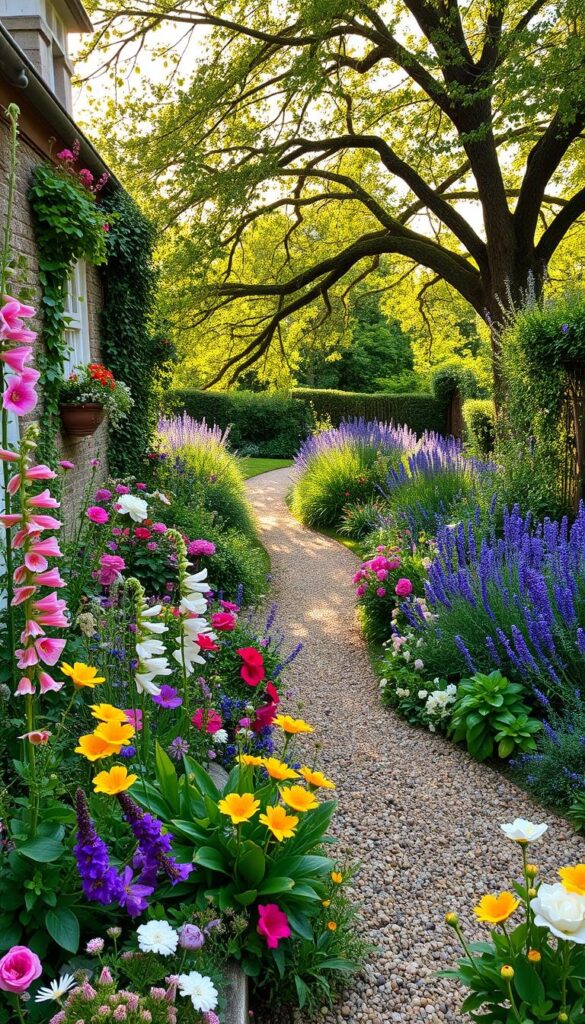
Lavender and Roses: Fragrant Classics
David Austin’s ‘The Poet’s Wife’ rose stays compact at 3 feet—perfect for pots. Unlike sprawling Knockouts, its honey-scented blooms reflower all season. Underplant with lavender ‘Hidcote’ for a purple-and-yellow duo that deters pests naturally.
Pro tip: Prune roses to 12 inches in early spring. This forces bushier growth in tight quarters.
Foxgloves and Sweet Peas: Vertical Bloomers
Dwarf foxglove ‘Camelot Cream’ thrives in 10-inch containers, shooting up 2-foot spires. Train sweet peas on obelisks—their tendrils climb fast, hiding supports in weeks. JR Peters’ front yard scheme alternates these with blue salvia for rhythm.
For continuous color:
- Sow sweet peas every 3 weeks
- Plant foxgloves behind lower-growing thyme
Daisies and Zinnias: Cheerful Fillers
Zinnia ‘Thumbelina’ blooms at just 6 inches tall, ideal for edging. Save seeds by letting late-summer flowers dry on stems. Pair with shasta daisies—their white petals make other colors pop.
Succession planting keeps beds lively:
- Spring: Daisies
- Summer: Zinnias
- Fall: Ornamental kale
8. Pathways and Seating Nooks
Every great garden needs a place to pause—paths and seating turn functional spaces into destinations. Sugar & Cloth’s faux grass stepping stones prove even concrete balconies can feel lush. These durable tiles interlock like puzzle pieces for a finished look.

Faux Grass Stepping Stones
UV-resistant synthetic turf stays green year-round with zero mowing. Install them as:
- Guides to potting stations
- Alternating patches between gravel
- Rooftop garden pathways
Curved Gravel Paths with Flower Borders
Use a garden hose to map serpentine routes—the curves make small areas feel larger. Winding path designs recommend:
- Pea gravel (low maintenance) vs. wood chips (needs replenishing)
- Drought-tolerant sedum edges
- Solar cap lights every 3 feet
Bench Under a Flowering Arch
JR P’s wisteria-draped bench creates instant shade. The vines climb powder-coated steel arches in one season. Pro tip: Train branches horizontally along the top for denser coverage.
These elements transform tight corners into intentional retreats. Your home’s exterior gains purpose—and personality—one stone or seat at a time.
9. Upcycled Garden Decor
Your garden decor doesn’t need a big budget—just a little creativity. Repurposed items add personality while keeping costs low. These projects turn forgotten objects into functional art.
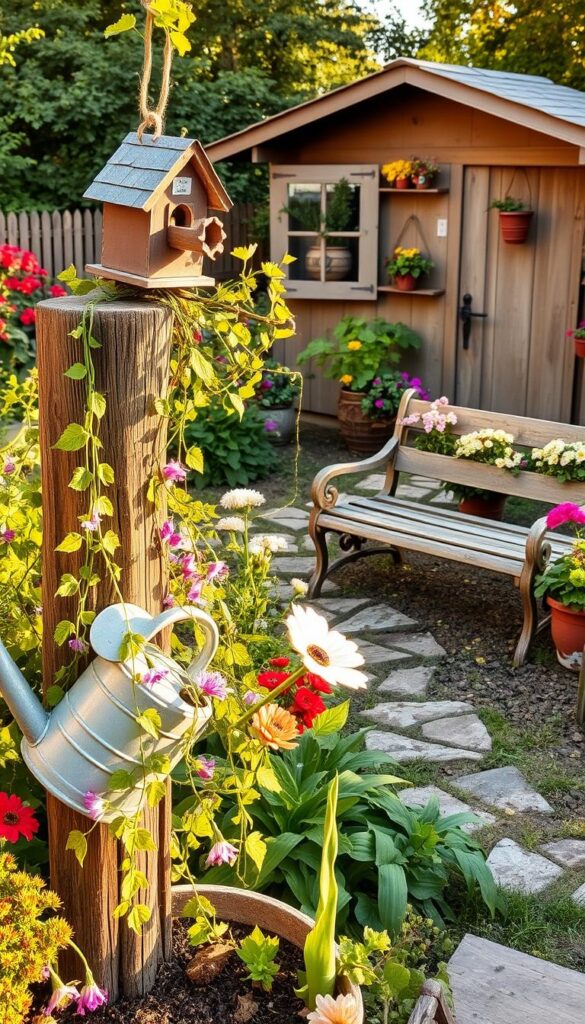
Pallet Planters for Herbs
Buff Strickland’s tutorial shows how to sand pallets smooth without losing their rustic charm. Seal the wood with outdoor-grade polyurethane to prevent rot. The vertical slats become perfect pockets for herbs.
Contain mint in its own section—this spreader will take over if given space. Try these arrangements:
- Basil + thyme in top pockets
- Parsley center row with oregano
- Chives along the bottom edge
Vintage Wind Chimes and Birdhouses
Christian Durocher places chimes near seating areas where breezes catch them best. Upcycle silverware or keys for unique clappers. The metallic tones attract birds while adding whimsy.
Tater Tots and Jello’s marker project labels plants with vintage spoons. For tiny succulents, try:
- Teacups with drainage holes drilled
- Chipped creamers as mini planters
- Mismatched saucers under thrifted pots
These touches make your space feel curated, not cluttered. Every piece tells a story—without costing a fortune.
10. Edible Cottage Gardens
Why choose between pretty and practical when your garden can deliver both? Edible plants like borage and strawberries add color while filling your kitchen with fresh flavors. Even a tiny plot can become a gourmet pantry with smart designs.
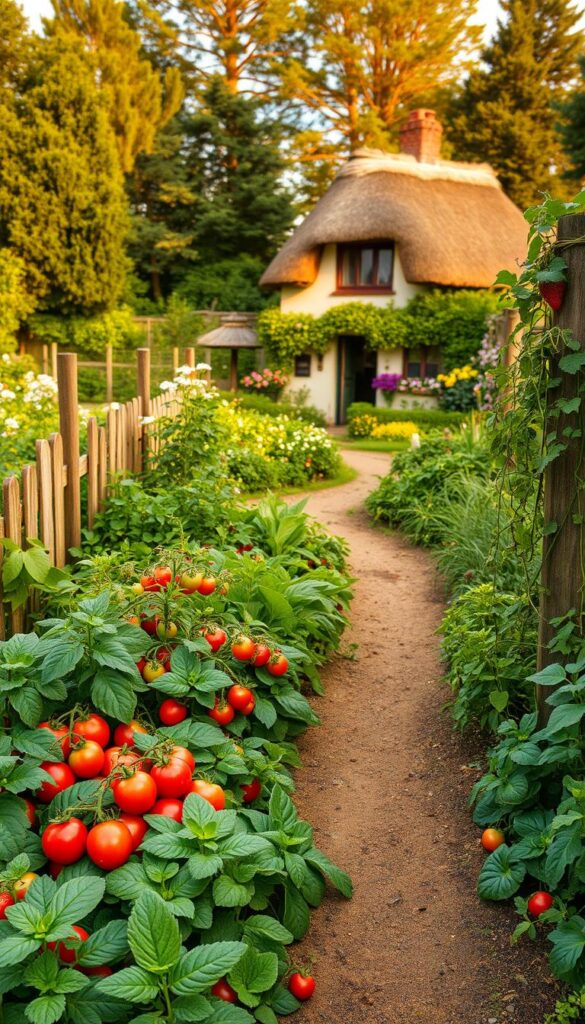
Cocktail Gardens with Herbs and Berries
Mojito mint varieties thrive in containers—try ‘Mentha x villosa’ for frost resistance. Inspired by Charm stacks them with lime thyme and alpine strawberries. The trio fits a 2-foot planter but fuels endless summer drinks.
For layered texture, plant trailing rosemary over pot edges. Its piney scent deters mosquitoes—a bonus for balcony happy hours. Pro tip: Use terra-cotta pots to regulate soil moisture for herbs.
Raised Beds for Vegetables and Flowers
Interplant nasturtiums with tomatoes—their peppery leaves repel aphids naturally. The orange blooms also spice up salads. Build a 3×3-foot bed with cedar planks for this powerhouse pair.
Strawberry towers maximize vertical space. Stack three 12-inch pots with drainage holes, filling each with everbearing varieties. Dwarf blueberry bushes like ‘Top Hat’ make sweet borders, staying compact at 18 inches tall.
- Edible flowers: Calendula petals brighten dishes while attracting pollinators
- Companion planting: Basil improves tomato flavor when grown nearby
- Space-saving: Train cucumbers up trellises behind lettuce beds
11. Lighting and Sun Catchers
Twinkling lights transform your outdoor space into a magical retreat—day or night. Whether it’s sunlight dancing through handmade sun catchers or fairy lights casting a soft glow, these touches add depth and whimsy. Best part? They’re easy to DIY.
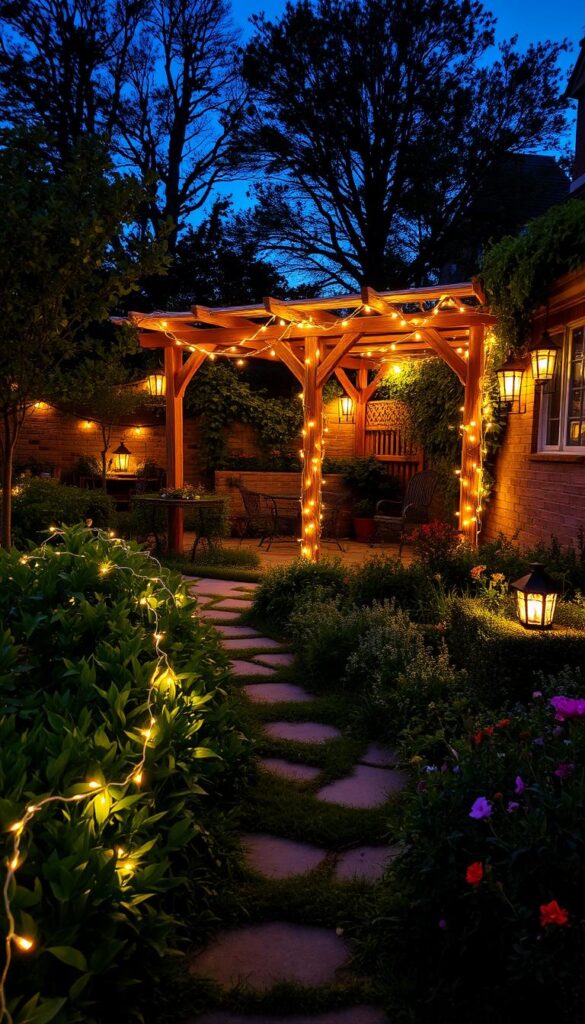
DIY Sunflower Sun Catchers
Crafting Cheerfully’s tutorial turns beads and wire into radiant sun catchers. Opt for amber and gold beads—they refract light like real sunflower petals. Hang them near seating areas to catch afternoon rays.
Pro tips:
- Use UV-resistant fishing line to prevent fading.
- Cluster 3–5 sun catchers at varying heights for impact.
- Add mirrored pieces for extra sparkle.
Fairy Lights for Evening Ambiance
Solar-powered lights win for eco-friendly ease, but plug-in strands offer brighter illumination. Waterproof connections with heat-shrink tubing—Buff Strickland’s hack ensures durability in rain.
For drama, uplight trees or trellises. Fireflies adore warm white LEDs—they mimic natural light. Try these placements:
- Weave lights through railings or arches.
- Drape them in glass jars for portable lanterns.
- Use timer plugs to automate dusk-to-dawn glow.
These lighting tricks make your garden feel larger—and lovelier—after dark.
12. Shade Solutions for Sunny Spots
Sun-drenched spaces need smart shade—without sacrificing style. Whether you’re battling balcony glare or a patio that bakes by noon, these fixes cool your retreat while keeping its charm intact.
Pergolas with Climbing Vines
Grapevines outpace hops for quick coverage—their tendrils cloak structures in weeks. Elke Borkowski’s hack? Weave fairy lights through the pergola’s beams. They sparkle at night without overheating leaves.
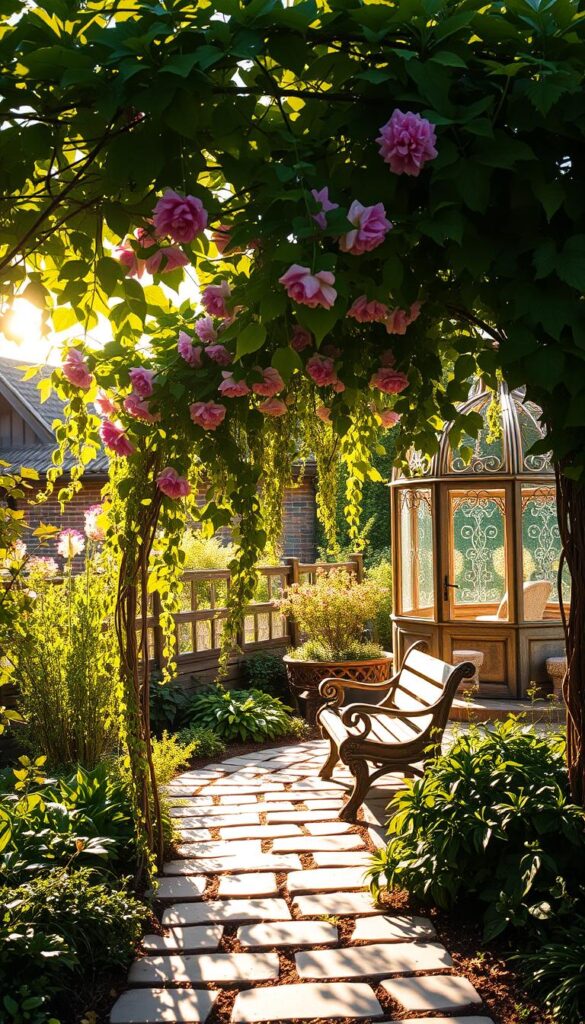
Underneath, plant ostrich ferns. Their feathery fronds thrive in dappled light. For extra texture, mix in hostas with variegated leaves.
Umbrellas and Canopies for Balconies
Sunbrella’s UV-resistant fabrics block rays without fading. Retractable awnings install in minutes—just secure the brackets to railings. Pro tip: Angle them southwest to block harsh afternoon light.
For tiny spaces, try cantilever umbrellas. Their offset poles won’t hog floor space. Pair with lightweight aluminum frames to withstand gusts.
- Fast growers: Dutchman’s pipe vine covers 10 feet per season
- Cool fabrics: Solution-dyed acrylic lasts 5x longer than polyester
- Low-light stars: Japanese painted ferns thrive with just 2 hours of sun
With these tweaks, your garden stays lush—no matter how high the mercury climbs.
13. Wildlife-Friendly Touches
Wildlife transforms your space into a lively sanctuary—here’s how to invite them in. From buzzing bees to chirping birds, these touches turn your plot into a thriving ecosystem. Even small changes make a big difference.
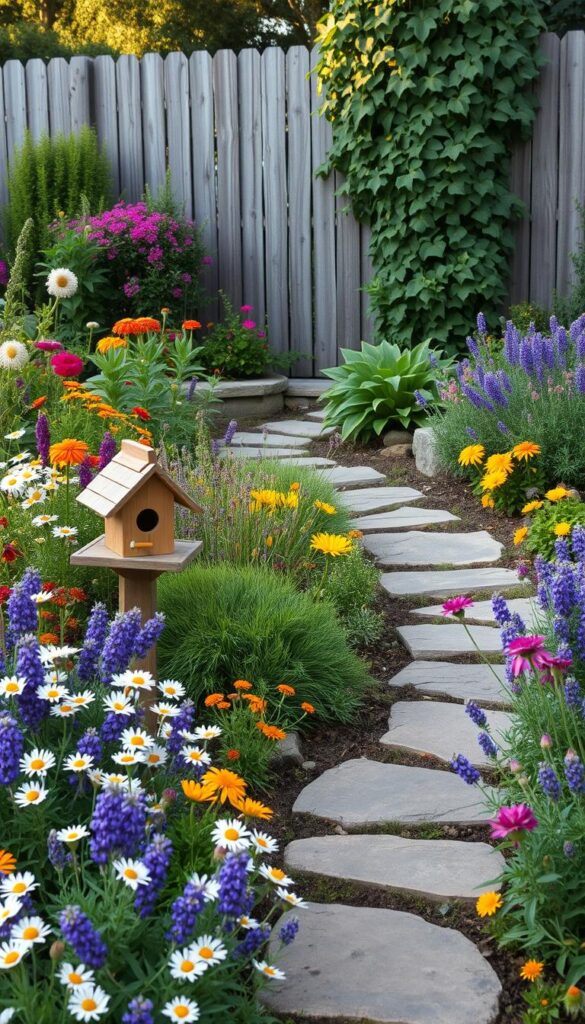
Bee-Friendly Flower Choices
Native plants like purple coneflower and goldenrod are pollinator magnets. They’re drought-resistant and bloom for months. Cluster them in sunny spots for maximum impact.
Pro tip: Avoid pesticides—they harm beneficial insects. Instead, plant marigolds to naturally deter pests.
Bird Feeders and Insect Hotels
Turn a drilled log into a bee house—just bundle hollow stems inside. Hang it facing east for morning warmth. For birds, try a squirrel-proof feeder with weight-activated perches.
Add a shallow dish with pebbles for butterflies to drink safely. Pair it with a bird bath arrangement to attract feathered visitors.
- Monarch waystations: Plant milkweed for migrating butterflies.
- Frog ramps: Slope stones in water features for easy access.
- Evergreen shrubs: Provide winter shelter for birds.
Your garden becomes a lifeline for local wildlife—one bloom or feeder at a time.
14. Seasonal Rotation Tips
Seasons change—your garden doesn’t have to fade with them. With clever plant picks and simple tricks, you’ll keep the charm alive all year. It’s like having a wardrobe for your plot: swap a few key pieces, and the show goes on.
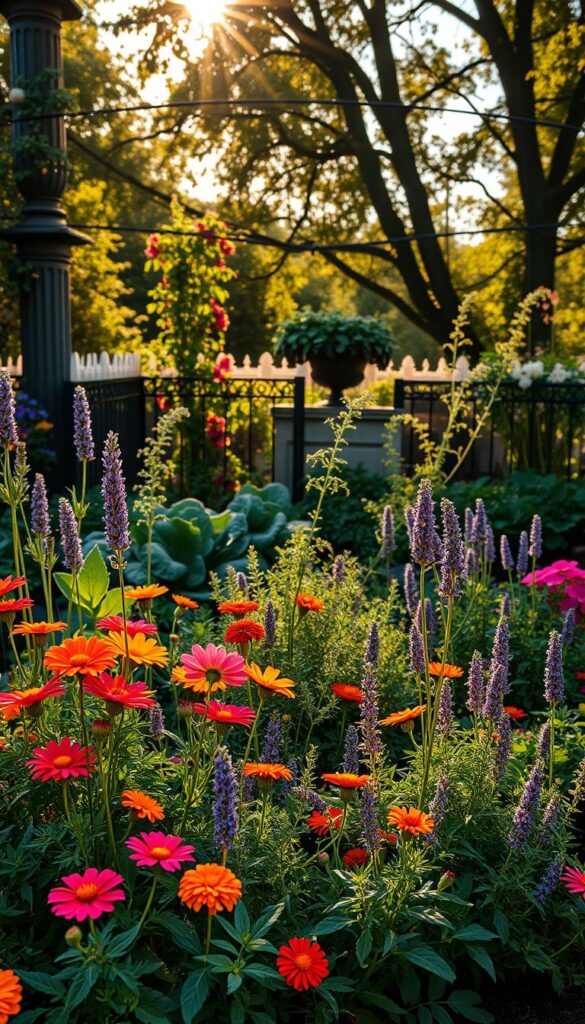
Spring Bulbs for Early Color
Forced tulips and daffodils bloom weeks early when chilled in paper bags for 12 weeks. Tuck them into pots with pansies—their cold tolerance stretches the display. Pro tip: Layer bulbs like lasagna (more on that below) for staggered surprises.
Dwarf iris ‘Katharine Hodgkin’ thrives in shallow beds. Its blue-and-yellow flowers pop through late snow. Pair with crocus for a carpet of purple and gold.
Evergreen Shrubs for Winter Interest
Boxwood’s tidy spheres outshine hollies in small spaces—no prickly leaves to navigate. ‘Sprinter’ stays compact at 3 feet, perfect for flanking entryways. For texture, try variegated euonymus; its gold-edged leaves glow against snow.
Hollies like ‘Sky Pencil’ add vertical drama. Their red berries feed birds while adding holiday cheer. Wrap trunks with LED lights (low-voltage to prevent burns).
- Lasagna planting: Stack bulbs by bloom time—late tulips deepest, early crocus on top.
- Fall transition: Replace spent annuals with ornamental kale—its frilly leaves frost-proof to 5°F.
- Lighting safety: Use GFCI outlets and solar strands near water features.
Your tiny oasis stays vibrant—no matter what the calendar says.
15. Maintenance Hacks for Small Gardens
Smart maintenance turns tiny plots into low-effort showstoppers—here’s how. With the right systems, you’ll spend less time working and more time soaking up the charm. These pro-approved tricks keep everything thriving without becoming a second job.
Deadheading Made Delicious
Your secateurs become salad scissors with the “snip and drop” method. As you remove spent blooms from calendula or pansies, let the petals drop onto soil as natural compost. Tilly Design’s rotation schedule pairs this with weekly herb trimmings—basil bits enrich tomato beds nearby.
For woody stems like roses, angle cuts above outward-facing leaf nodes. This encourages bushier growth in tight spaces. Bonus: Drop the cuttings into a mason jar with water for instant kitchen decor.
Mulch Magic
Cocoa bean mulch smells like chocolate while suppressing weeds, but it’s toxic to dogs. Rubber mulch lasts years without fading, though it doesn’t enrich soil. For best results:
- Layer 2 inches of cocoa mulch around ornamentals
- Use rubber mulch for pathways
- Top-dress veggie beds with straw (removes easily for replanting)
Felco’s ergonomic shears save hands during long pruning sessions. Store them vertically in a repurposed umbrella stand—saves space and keeps blades accessible. Set reminders in the Planta app for watering rotations; its AI adjusts schedules based on local weather.
With these systems, your garden stays gallery-worthy with barely any effort. Now go enjoy that iced tea among the blooms—you’ve earned it.
16. Start Your Cottage Garden Adventure Today
Your garden journey begins with a single plant—no perfection required. Pick one vertical element like Handmade Farmhouse’s trellis or Tilly Design’s raised beds. Even a potted vine on a balcony rail counts as progress.
Keep it simple. Track growth in a journal—note what thrives in your space. Resources like Sugar & Cloth’s faux grass paths prove smart design works anywhere.
Embrace the “imperfect progress” philosophy. Your home’s outdoor charm grows with each small step. Now go plant something—you’ve got this.


